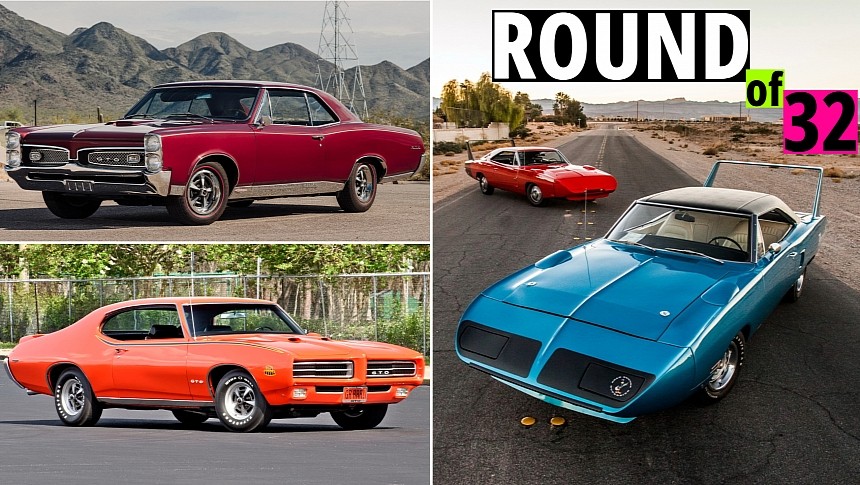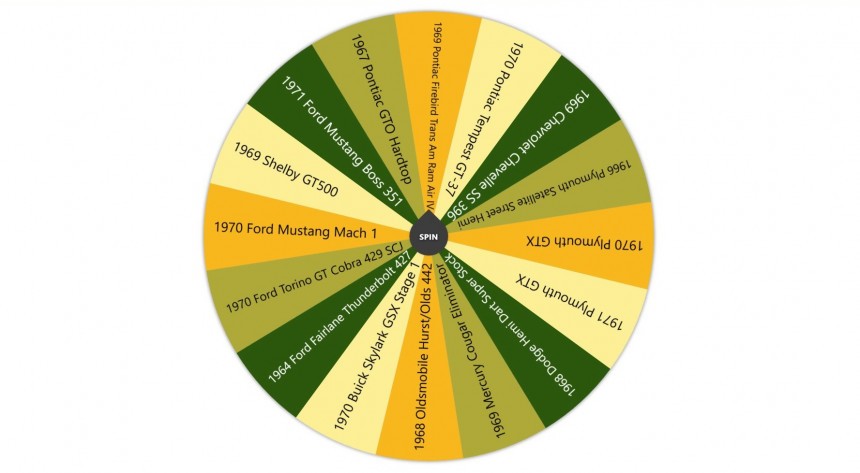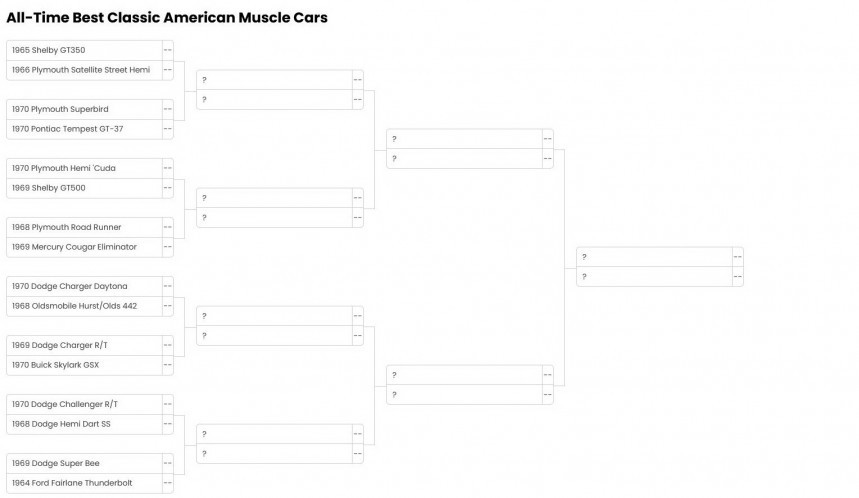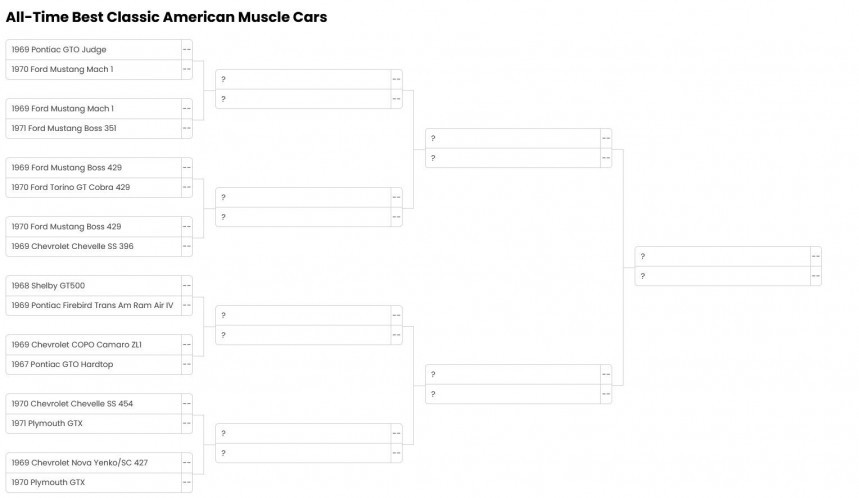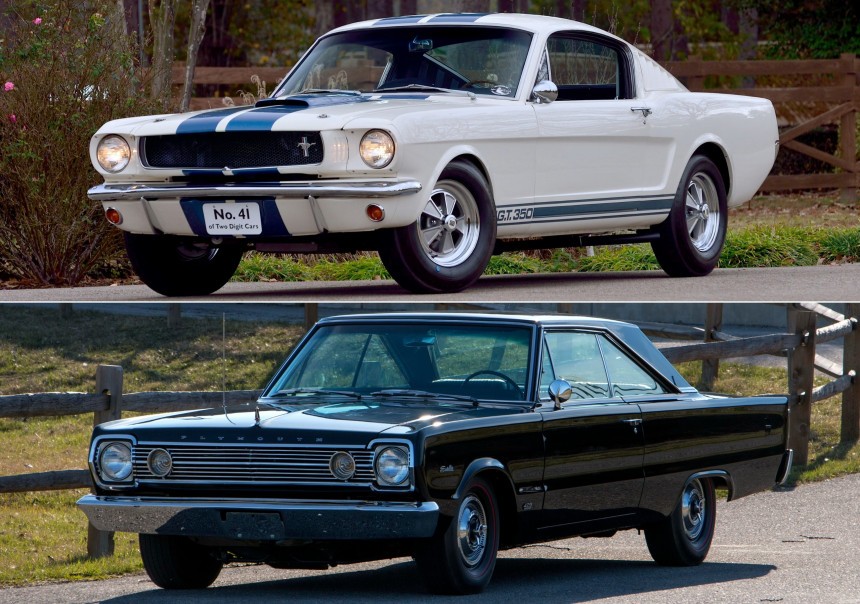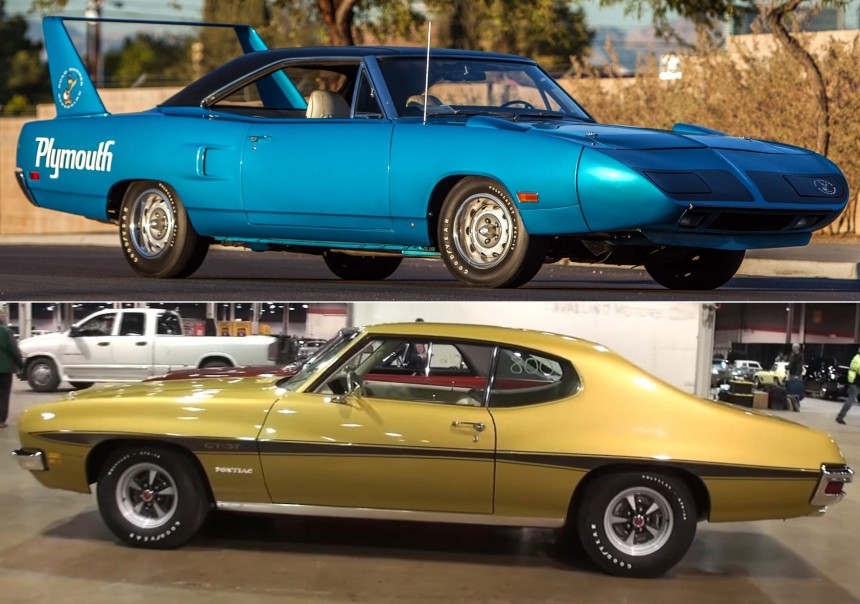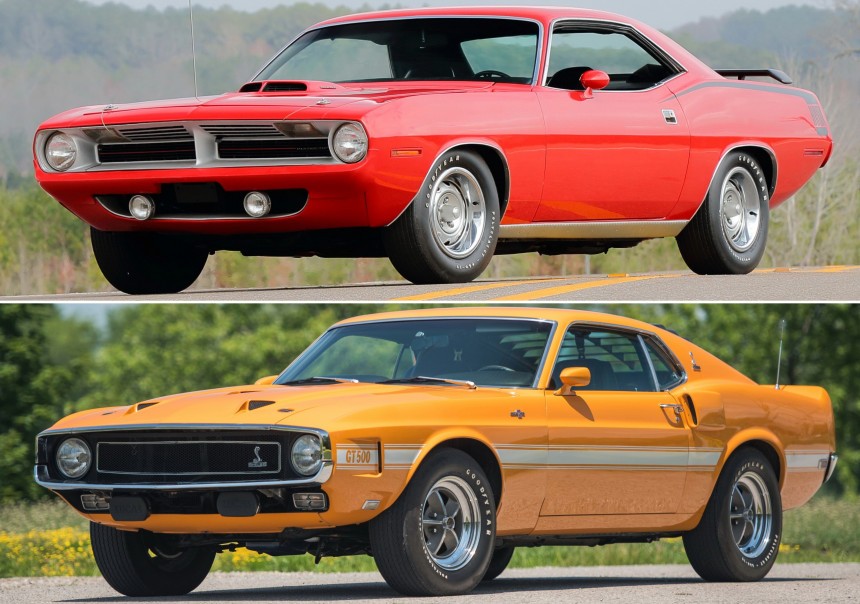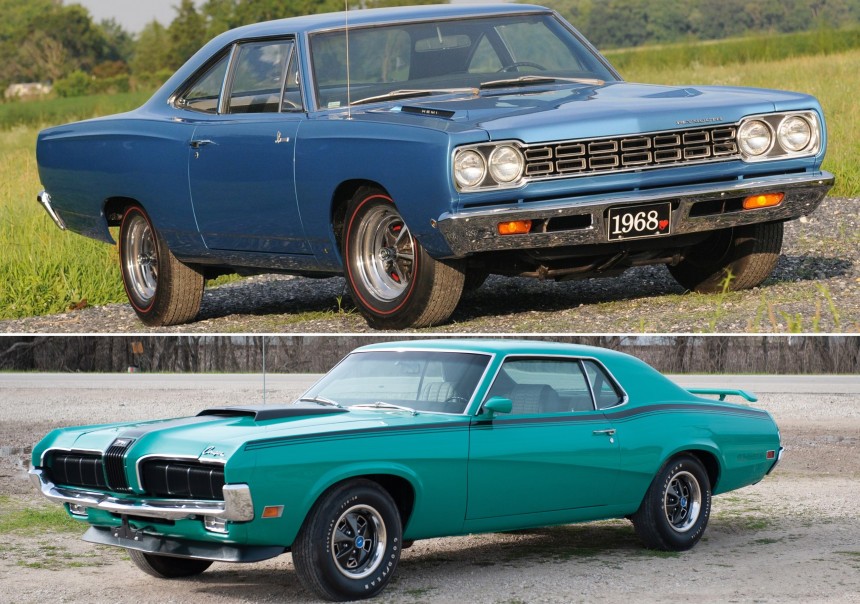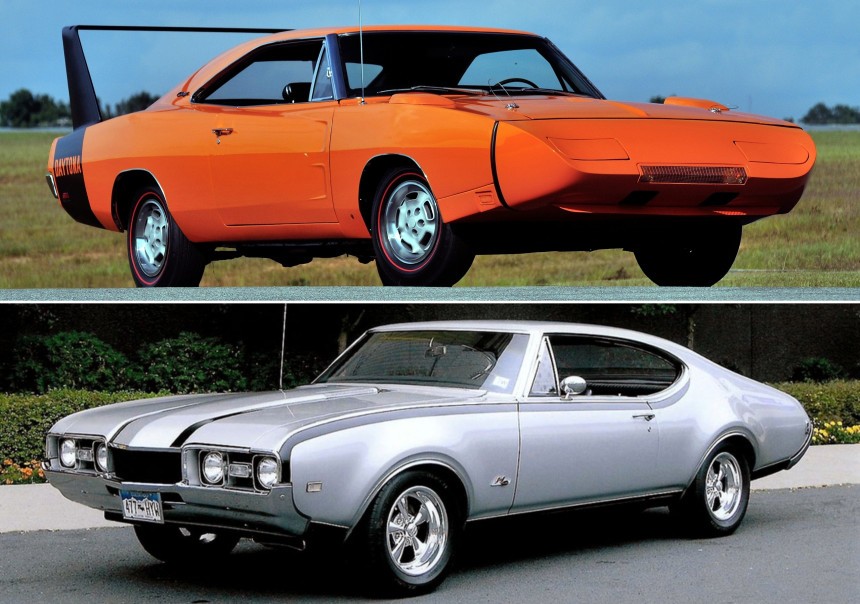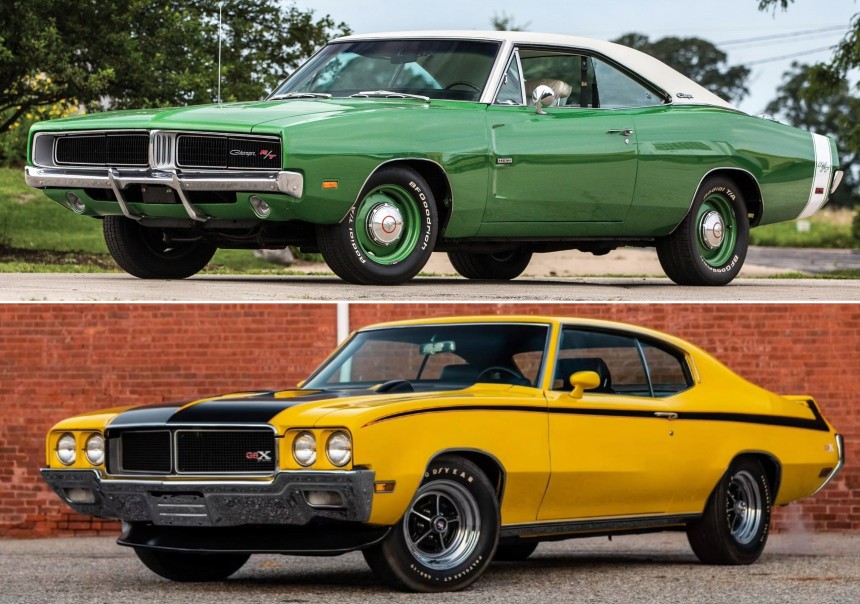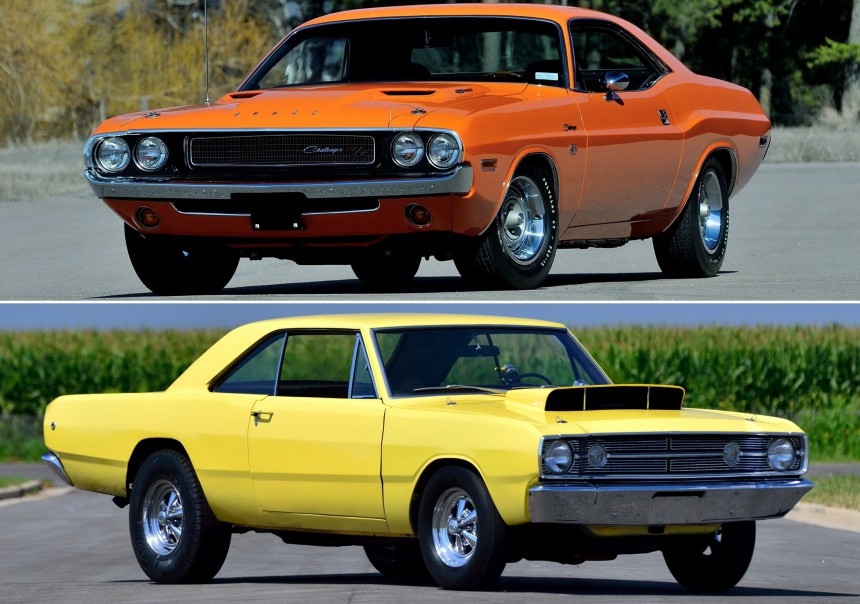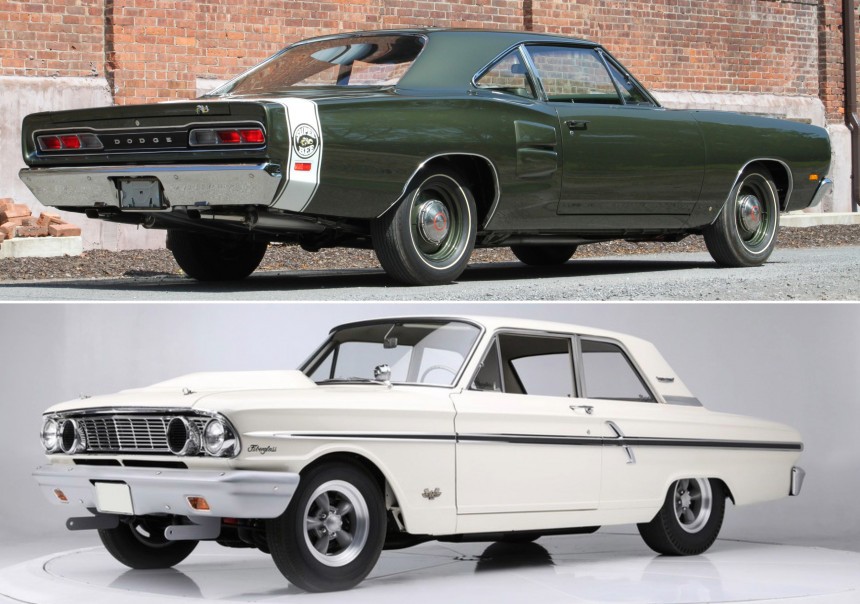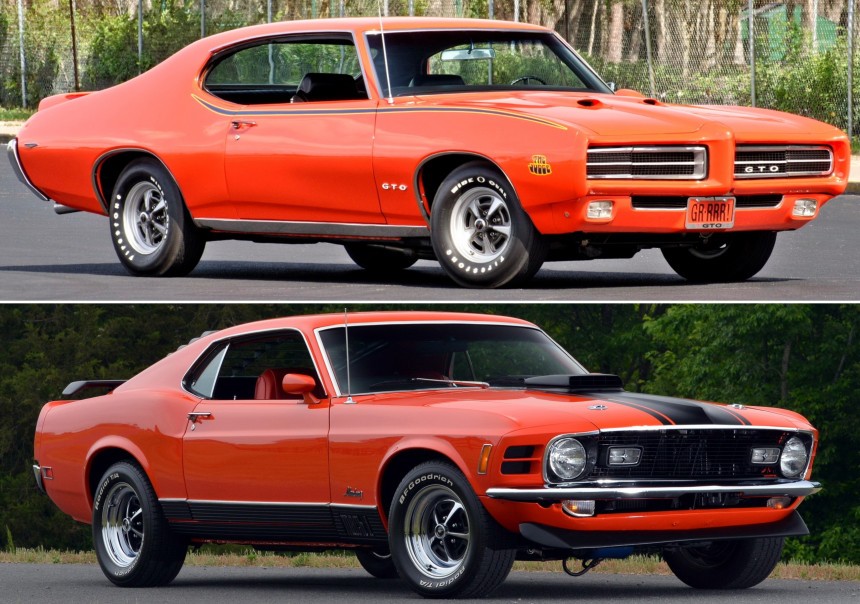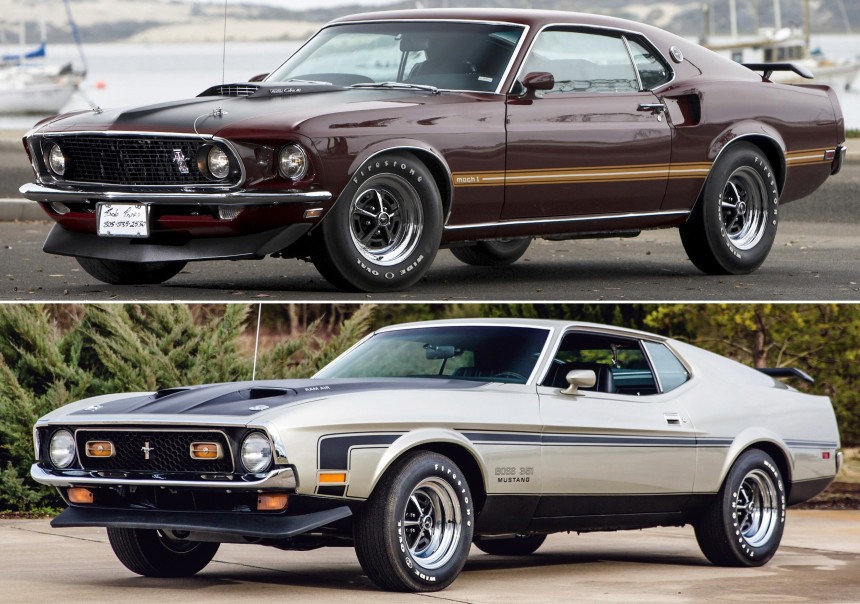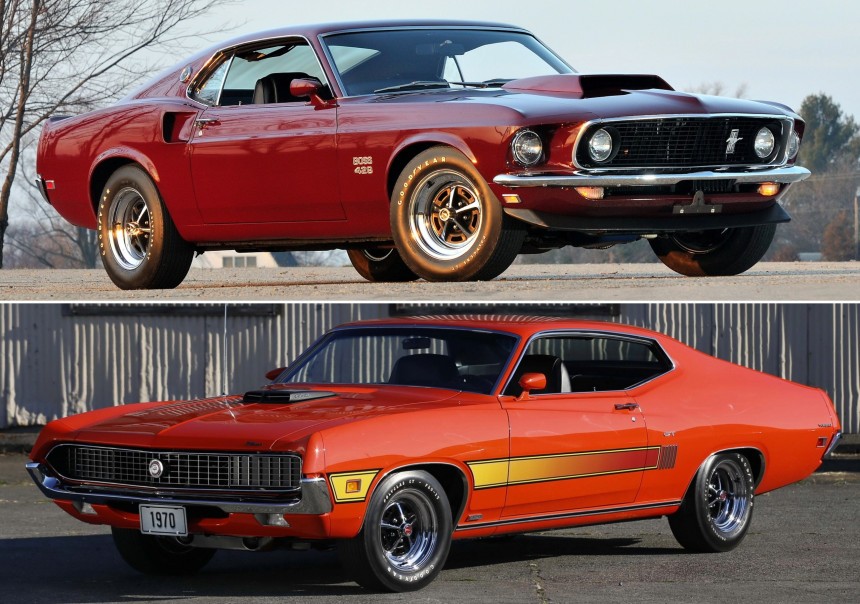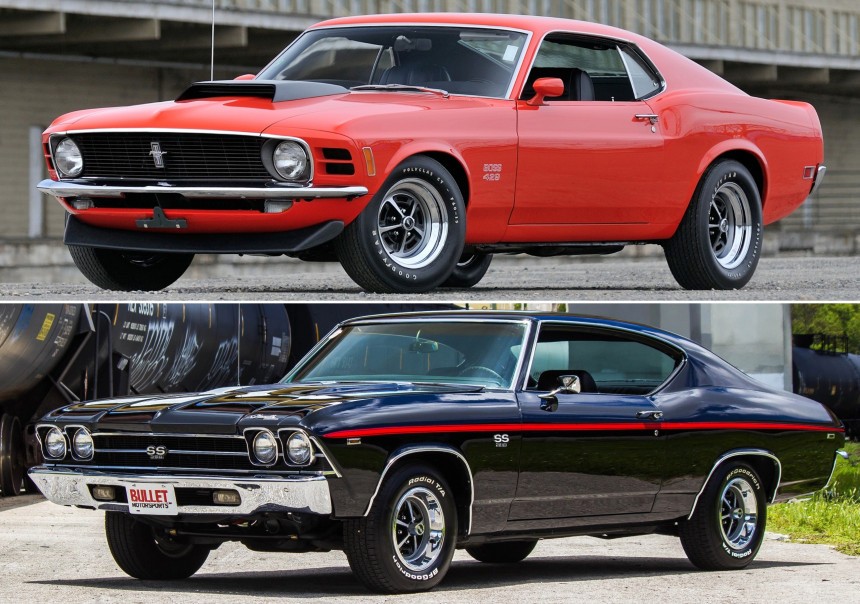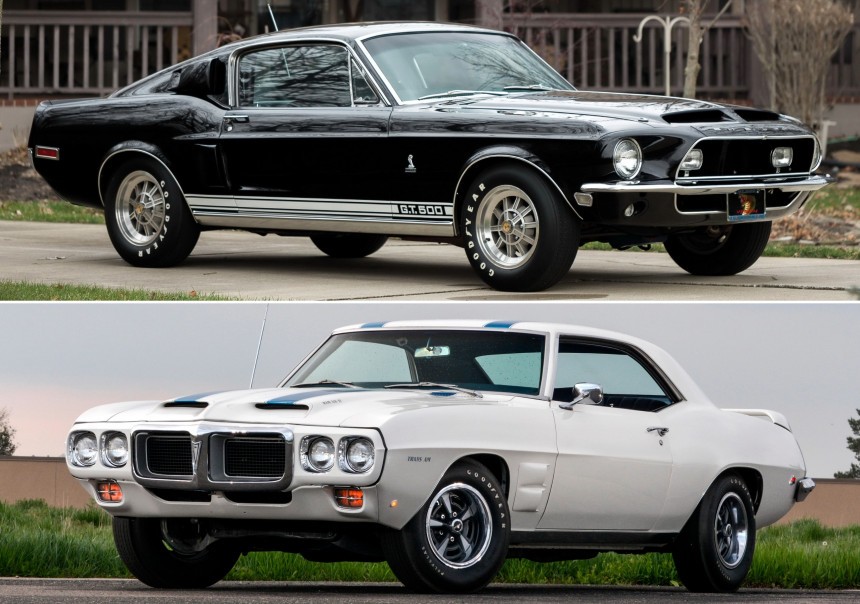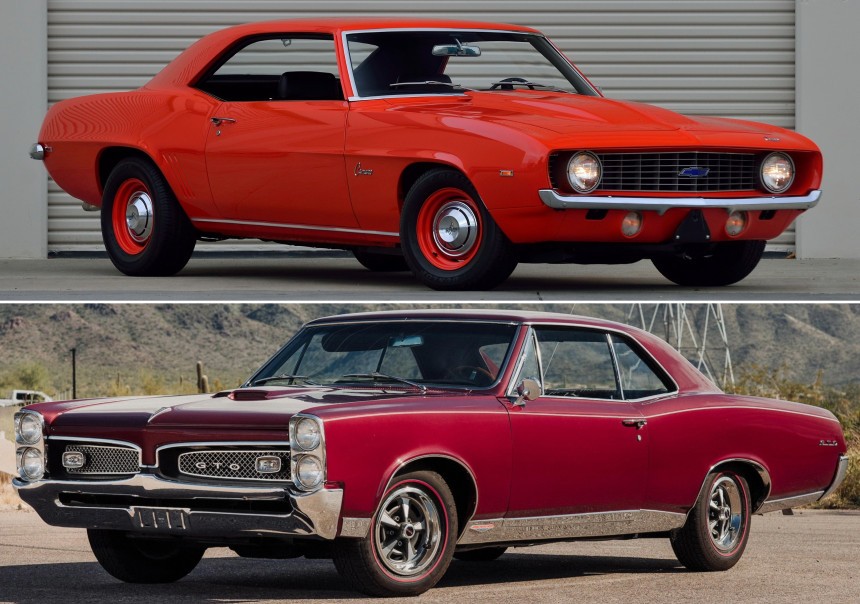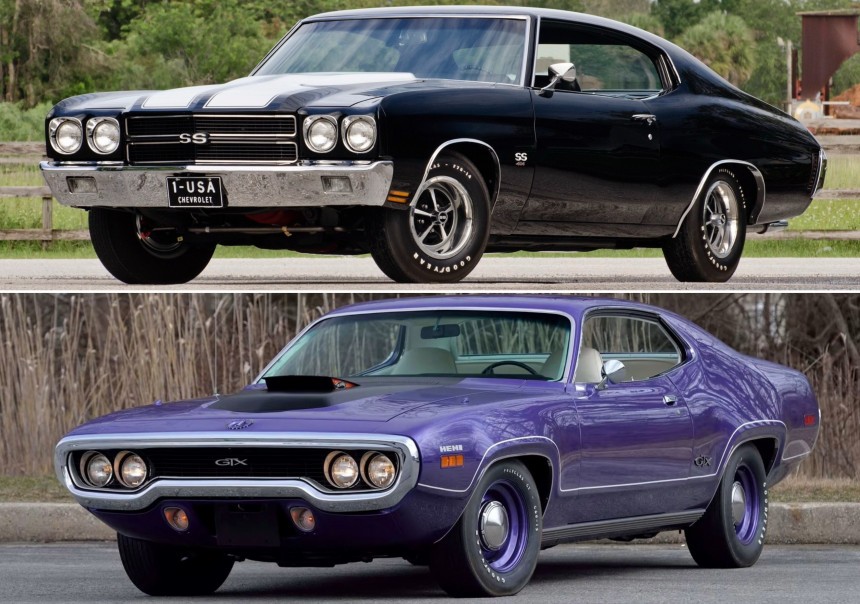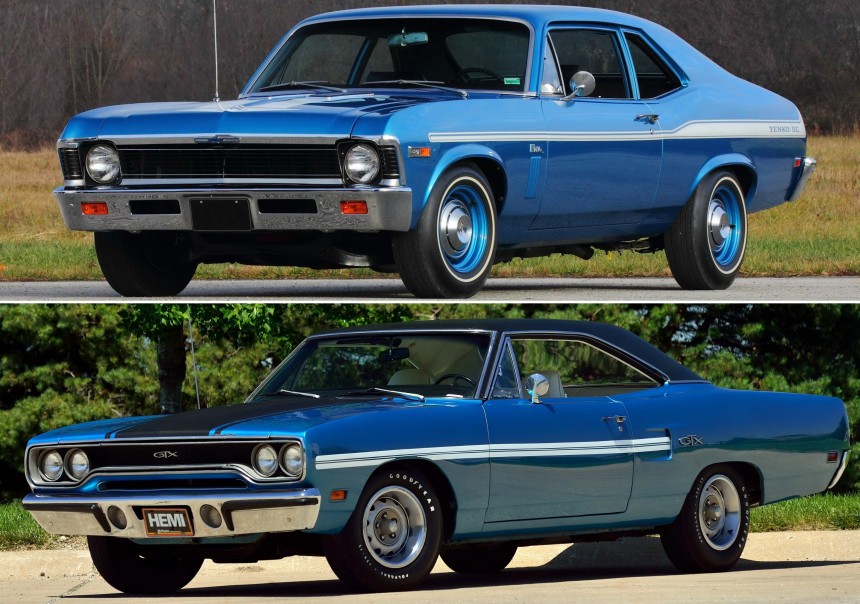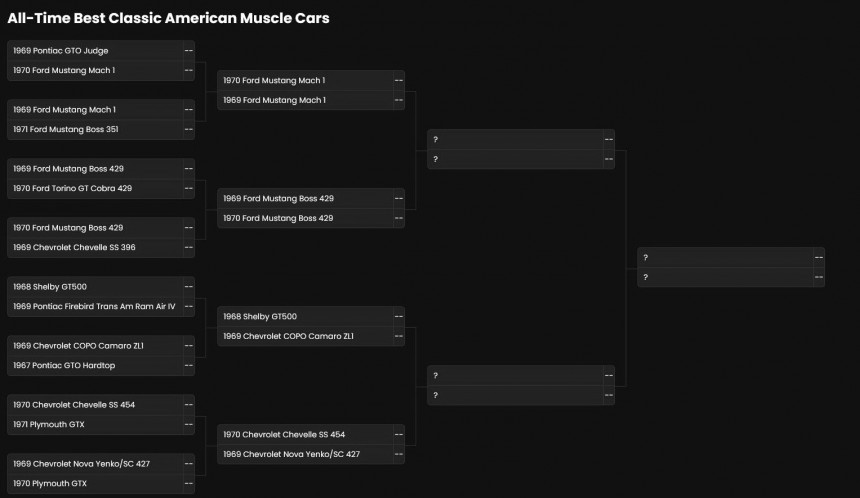How do you define the very best classic American muscle car ever made? Is there even a way to arrive at anything resembling an objective conclusion? These are questions we’re going to try to answer right here in this ginormous feature story, which will span several weeks up until the point we get to crown a winner.
Here’s the fun part though. We’ll be using a Playoff bracket style elimination format, just as you’d see in the NBA Playoffs or during March Madness. Why? Because we can, and because it offers us a chance to randomize some of the matchups, at least to some extent.
Let me walk you through the selection process first, followed by how we selected the matchups themselves – I promise, it’s worth it.
The first thing we had to do was pick out an even number that you can keep dividing by 2 until you’re literally left with 2, and 32 was an easy choice to make. The next best choice would have been 64, but we realized early on that we likely couldn’t come up with 64 truly great muscle cars. We could find 32, easily (a dozen or so worthy cars didn’t even make the cut), but not 64. Anyway, this was just the beginning.
This was the part that felt particularly subjective, which is why we went with a consensus, just so we wouldn’t split too many opinions right off the bat. Still, most of these cars were worthy of a “high seed”, but since they couldn’t all be one, we did end up with two or three “death matches” way earlier than expected.
After having selected 16 top seeds, we needed to match them up with the so-called underdogs, and to do that, we used an online random name picker, as shown in the image below. We simply spun that wheel each time we had to pick a matchup for one of the top seeds and it all worked like a charm.
I will admit that the top seeds were arranged in alphabetical order, as in a series of Fords, a series of Plymouths etc. The reason being it would guarantee that muscle cars from the same brand would face each other more often than not in the second and third elimination rounds, rather than in the semi-final or the final.
Finally, we needed to figure out the criteria for how we’d score these rounds, and we arrived at the following factors: icon status, collector’s status, performance and looks, with a focus on the latter two. Why? Because if we focused on how iconic of a muscle car the winner was, it would be the equivalent of asking who’s the best basketball player of all time and settling on Bill Russell just because he won 11 rings.
Yes, icon status is important, but the winner of this bracket has to be the type of car you’d want to take out for a spin every single day, grinning the whole way.
Now that that’s settled, it’s time to check out the Round of 32 bracket, which we’ve split in two for the purpose of this article, but don’t worry, we’ll only need one bracket come next week.
Happy with the matchups? Great, because it’s time to get to it and figure out who’s worthy of advancing to the Sweet 16 round.
The original Shelby GT350 went into this matchup as a heavy favorite, mostly because of its icon status and how valuable it is today as a collector’s item. Having said that, from a performance standpoint, the so-called “Street Hemi” specification of the first-generation Plymouth Satellite was a beast, and a heck of a lot more capable in a straight line than the Shelby.
Powering the latter is a 289 ci V8 engine, which with the help of a larger 4-barrel Holley carburetor, would produce 306 horsepower and 329 lb-ft of torque. These original GT350 cars weren’t particularly easy to drive, because they were not built with everyday driving in mind, whereas the Satellite would have proven a lot easier to live with as a “daily”.
Speaking of the Plymouth, its 426 ci V8 Street Hemi engine was rated at 425 horsepower and 490 lb-ft of torque, making the Satellite one of the most powerful production cars of the mid-60s era, which makes having to choose a winner between the two of them particularly difficult since performance is so important.
In terms of aesthetics, I think both are absolutely terrific, but it’s the Mustang that looks more like a sports coupe, rather than a 2-door sedan. Add to that its unwavering icon status and the decision can only go one way.
Winner: 1965 Shelby GT350
In terms of power units, buyers could choose between three options, the best of which was a massive 426 ci (7.0L) HEMI V8 engine, working alongside two four-barrel carburetors to produce 425 horsepower and 490 lb-ft of torque.
There were only 135 cars built that featured this 426 HEMI powertrain, making the flagship-spec Superbird a... rare bird, pun intended.
Aside from being rare, this was also extremely quick for its time, capable of hitting 60 mph from a standstill in around 5 seconds. To put things into perspective, it would have been about as quick as a 2001 Mercedes CL 63 AMG.
As for the Pontiac GT-37, I bet some of you didn’t even know it existed. Back when it came out, the marketing people at Pontiac made the following statement: “If you’re after the response of a GTO, but you’re willing to sacrifice some of the frills, remember this simple code: GT-37.”
You could choose between several V8 options in terms of power units, but the cream of the crop would have been the 455 ci HO LS5, good for 335 horsepower and 480 lb-ft of torque. This car was rarer, cheaper and quicker than a GTO, while still packing goodies such as a heavy-duty Muncie 3-speed transmission, floor-mounted Hurst shifter, Rally II wheels, hood locking pins, plus vinyl accent striping.
Bottom line, the GT-37 was a tremendous muscle car, a true metaphorical dark horse. Unfortunately, to beat the Superbird you need to be an all-time great. It’s as simple as that.
Winner: 1970 Plymouth Superbird
Boy, this was a tough one! In one corner, a genuine heavyweight in the Hemi ‘Cuda, going up against perhaps one of the “lesser” Shelby GT500 variants, yet one that is still a formidable foe.
I couldn’t have predicted which car was going to challenge this hardcore Plymouth Barracuda in the Round of 32, but I knew that it would have its work cut out. Here’s what’s important to remember about the Hemi ‘Cuda: 426 ci (7.0L) V8, 425 horsepower, 0-60 mph in under 6 seconds.
This was also a 14-second car over a quarter mile, which used to be a genuinely good time back in the late 60s and early 70s.
Aside from its performance, the Barracuda is, in general, a very good looking 2-door hardtop coupe, just like its Dodge Challenger sibling. Meanwhile, the 1969 Shelby GT500 isn’t exactly one of the most good-looking Mustangs ever built.
Don’t get me wrong, it’s not ugly or anything, but its “personality” seems a bit off, courtesy of that extensive facelift for the 1969 model year.
As for available power trains, there was just one option in the 428 ci (7.0L) Cobra Jet V8, good for “just” 335 horsepower. Basically, the Hemi ‘Cuda has this GT500 beat on performance and looks alone, which unfortunately for all you Mustang fans out there, is more than enough to clinch this battle.
Winner: 1970 Plymouth Hemi ‘Cuda
That’s where the 426 ci Hemi V8 came into play as a $718 option at that time. By the way, this engine is going to be featured on a lot of these cars, so hopefully it won’t feel too repetitive, but hey, them’s the breaks!
So then, with 425 horsepower and 490 lb-ft of torque at its disposal, the Road Runner feared very few cars on the road during an era that can be considered the golden age of the Plymouth brand.
But how does it compare to a 1969 Mercury Cougar Eliminator? The latter is kind of at a disadvantage, seeing as how it was more of a pony car rather than a muscle car, but we won’t be making that distinction here, because muscle is muscle.
Anyway, the Cougar Eliminator had a 290 hp Boss 302 engine under the hood, in most cases, which was fine, but would have been completely underpowered if compared to a large Hemi V8. Luckily, there were a few Eliminators fitted with the Ram Air 428 ci engine, good for 335 horsepower. I personally didn’t know this, but it’s on the Internet, so it must be true.
Winner: 1968 Plymouth Road Runner
Stepping into the ring as favorite for this matchup is, of course, the Charger Daytona, with its NASCAR bones and record-breaking accolades – it was a Charger Daytona that broke the 200 mph (322 kph) mark for the first time in NASCAR, back in 1970 at Talladega.
Anyway, there’s no mistaking this car for anything else on the road – other than a Superbird, that is. Still, there are subtle differences between them, and a keen-eyed observer could easily tell them apart without having to look closely.
Unlike the regular Charger, the Daytona came with that massive 23-inch-tall wing at the back, a custom sheet-metal nose section, fender-mounted cooling scoops, plus heavy-duty suspension and brakes as standard, to handle the 440 ci Magnum V8 engine.
However, if you fancy yourself a collector, you’ll want the 426 ci Hemi V8 variants, because only 70 cars were made in this specification, packing those familiar 425 horsepower and 490 lb-ft of torque.
By comparison, the Hurst/Olds is a bit of an underdog, but not by that much. For starters, only 515 units were made for the 1968 model year, powered by a 455 ci Rocket V8, good for 390 horsepower and 500 lb-ft of torque. This thing was a beast, and GM really put in the effort to engineer these cars properly.
So, since there’s not much between them in terms of performance, and beauty is in the eye of the beholder, I’m afraid there’s no choice but to go with the more iconic car over the lesser known one. Rest assured though; this matchup nearly ended in an upset.
Winner: 1970 Dodge Charger Daytona
Muscle cars don’t get a lot more legendary than the 1969 Dodge Charger, although I welcome the debate whether or not the 1968 model year cars were better.
The legend took off back in 1968 when a Charger R/T took to the screen next to a Mustang GT in the movie Bullitt for one of the most amazing car chase sequences ever filmed. That car was a Charger R/T 440, but we’re here to talk about the 426 ci Hemi V8 again, with its 425 horsepower.
Truth be told, there isn’t much to say here, aside from the fact that the late 60s Charger is considered one of the best-looking muscle cars of its era, and since it scores highly in pretty much every single other department too, well, it would take a heck of a punch from the Buick GSX in order for it to get rattled.
Still, the GSX Stage 1 is no scrub. This Skylark-based muscle car was aimed at the Pontiac GTO and the Chevelle SS, rocking a 455 ci V8 – with some buyers opting for the Stage 1 optional package which delivered 360 horsepower and 510 lb-ft of torque. Basically, less power but more torque than the Hemi-powered Charger R/T. In the end, there can only be one victor though, and I’m sure everyone here agrees.
Winner: 1969 Dodge Charger R/T
The Dodge Challenger certainly doesn’t require any introduction. It enters this matchup as the heavy favorite, in R/T (Road/Track) specification, with power coming from the eternal 426 ci Hemi V8 with its 425 horses. The best part was that you could get this car either as a 2-door hardtop or a convertible, which meant there was a Challenger out there for everyone.
Its opponent, as far as this story is concerned, is the limited option Hemi Dart, also from Dodge. This Hurst-reworked muscle car brings to the table the exact same Hemi engine found on the Challenger R/T, so there’s no real discrepancy here in terms of performance.
Otherwise, these are two very different muscle cars, with the Challenger being more of a large GT car, whereas the Hemi-powered Dart was looking to conquer the drag racing scene. I’m serious. Since they weighed just 3,000 lbs, Dodge had to put out actual disclaimers so that people would know to only use them for “supervised acceleration trials,” aka drag racing.
Knowing that, plus the fact that only 80 units were ever built, makes the Hemi Dart one of the most intriguing muscle cars in American history. I was going to hand it the win here – an upset over the heavy favorite, but in the end I just had to go with the icon status.
Pity, because the Hemi Dart could have gone far in this “tournament”.
Winner: 1970 Dodge Challenger R/T
For the 1969 model year, Dodge introduced a hardtop variant to the range, and a “six-pack” version of the 440 ci engine, bringing the output to 390 horsepower. Still, you could have this car with the 426 Hemi V8, giving you those coveted 425 hp and 490 lb-ft of torque. Fun fact, those Hemi specs are rare enough that you can’t even find a good front ¾ angle image on Google – at least when you’re not willing to cut any corners.
Now, as luck would have it, the 1964 Ford Fairlane Thunderbolt also comes with 425 horsepower, but this is a completely different type of monster. It had a NASCAR-derived 427 ci V8 with dual 4-barrel carburetors, but those figures were somewhat conservative. Some people believed this monster put down closer to 600 horsepower, making it truly formidable for straight line acceleration.
How formidable, you ask? The Thunderbolt reportedly ran an 11.61-second quarter mile at 124.8 mph at Lions Drag Strip in 1963, which is downright insane. Not enough to topple the ultra-charismatic Super Bee, but still, wow.
Winner: 1969 Dodge Super Bee
We’re about midway through the Round of 32 and we’re finally done with all those Dodge models. Done as in, they’ve all moved on to the next round and we no longer have to deal with them, for now. The thing is, this second part of the story is going to include a lot of Chevy models, and a boatload of Mustangs too, so get ready.
Starting us off is a matchup between the top-seeded 1969 Pontiac GTO ‘Judge’ and the 1970 Ford Mustang Mach 1. Let’s start with the Pontiac.
All rise for the infamous GTO “The Judge”, named after a comedy routine from an old TV Show. Old by today’s standards, I mean. Anyway, these were serious performers in terms of specs, especially those Ram Air III variants with their 366 horsepower. I don’t want to talk about those though.
Let’s discuss the super-rare Ram Air IV-equipped GTO Judge, of which only 239 units were ever produced featuring the factory 4-speed close-ratio manual gearbox. They had a bit more power at 370 horses, to go with 445 lb-ft of torque.
When pitted against a 1970 Ford Mustang Mach 1, you’d think the GTO Judge would stand more than just a good chance to come out on top. For starters, those 1970 model year Mustangs were redesigned to look less aggressive than their 1969 counterparts, and the best you could do in terms of performance was to get the 428 ci Cobra Jet V8 unit with its 335 horsepower.
Some claim that the horsepower rating for the 428 CJ unit was too low, and that those cars actually put down in excess of 400 hp. In reality, they probably made about 10% more power than advertised, which would match what you got in the Ram Air IV GTO Judge perfectly.
So then, who’s coming out on top? Surely the GTO Judge? Well, while Mach 1 Mustangs are a dime a dozen, Cobra Jet-equipped ones are still some of the most sought-after American classics of all time.
Winner: 1970 Ford Mustang Mach 1
The ‘69 Mach 1 has everything, from the somewhat controversial quad headlights (some people love them), to the convex side panels, dual exhaust setup, matte black hood with a functional scoop and NASCAR-style cable and pin tiedowns, plus the wing at the back, chin spoiler and the louvered rear window.
As for the engine we’ve chosen for this little comparison of ours, that would be the 428 ci Cobra Jet / Super Cobra Jet V8, good for 335 horsepower and 440 lb-ft of torque.
Moving on to the 1971 Mustang Boss 351, and you can tell that in terms of styling, this is a completely different car – Ford deciding yet again to grow the model in size. Still, those Boss 351 Mustangs did sort of look like their contemporary Mach 1 siblings, which was a good thing.
In terms of specs, that 351 ci V8 engine came with 330 horsepower and 370 lb-ft of torque, which is “competitive”, but not quite as good as what you got in the ‘69 Mach 1, which by the way walks out of here in a blowout win.
Winner: 1969 Ford Mustang Mach 1
Remember when I said the ‘69 Mach 1 was a Top 3 all-time Mustang? Guess who else is in that Top 3. That’s right, the Boss 429 from that same model year. Simply put, a beast of a car, created specifically to homologate the 7.0-liter Boss 429 engine for NASCAR use, which meant these babies were a force to be reckoned with both on the street and on the race track.
In terms of specs, the 429 ci V8 is good for 375 hp and 450 lb-ft of torque, which is the same output you got in the 1970 Ford Torino GT equipped with the 429 ci Super Cobra Jet engine. This was part of the Drag Pack option for that model year and transformed the Ford Torino into a semi-decent muscle car.
Alright, it was more than just decent, but let’s not forget how high our standards have to be for the purposes of what we’re trying to do here. For a Torino GT, even a SCJ-equipped one, to beat any Boss-spec Mustang (let alone ‘69 model), it would need to be beyond great at what it did. Sadly, that wasn’t the case, but we still respect the heck out of it.
Winner: 1969 Ford Mustang Boss 429
This might very well be the most well-balanced matchup we’ve had so far. Two great American classics, with similar specs, similar icon statuses, and just as desirable when trying to purchase one today – or are they?
Let’s start with the 1970 Mustang Boss 429, which differs from that 1969 model which crushed the Torino GT like Thanos stepping on a grape.
Unlike the car I jokingly compared to the MCU’s favorite-ever villain, the ‘70 Boss 429, as every other 1970MY Mustang, came with a more simplified design. No more extra grille-mounted headlights, and no more rear fender air scoops. The rear taillight panel was also modified, featuring a flat aesthetic instead of concave.
I don’t mind the differences that much though. I used to, but not anymore. I still consider the 1969 variant superior, but to say that any 1970MY Mustang isn’t absolutely fetching, would be ridiculous.
As for performance, we’re dealing with the exact same 429 ci V8 we just talked about in the previous comparison, putting down 375 horsepower.
In the other corner, wearing all black and a red stripe, is the mighty 1969 Chevrolet Chevelle SS 396, possibly one of the most popular classic muscle cars in the world right now. Unsurprisingly, these were extremely sought after back then too, with 1969 Chevelles earning the moniker “American’s most popular mid-size car.”
In SS 396 spec, power came from a 396 ci (6.5L) Big-Block V8, good for 375 horsepower, just like the Boss 429. Oh, and yes, maybe it would have been more “fair” to compare the ‘69 Chevelle SS with the ‘69 Boss 429, but remember, I used that random name picker for that, so take it up with them.
Anyway, the Chevelle was not only quick, but also great-looking, with those sweeping panels and curvy lines. Absolutely gorgeous from just about every angle.
I’ll be honest, this feels almost like a 50/50 choice, and we’ve already had several Mustangs advance to the next round, so helping the Chevelle SS 396 escape with the win might be the right thing to do. The thing is, the Boss 429 is a much rarer car, regardless of model year, which means that for a collector, this decision would be sort of a no-brainer.
Winner: 1970 Ford Mustang Boss 429
This is the last Mustang for now, I promise. I know you’re probably sick of them by now. Just kidding, I know you’re not, because who doesn’t love Mustangs? But seriously, the 1968 Shelby GT500 is the last Mustang we’ll be discussing in the Round of 32, and its randomly chosen opponent is none other than the 1969 Pontiac Firebird Trans Am.
Yet another extremely close fight, as far as I’m concerned. But let’s start with the 1968 Shelby GT500, with the engine of choice being either the 428 ci police interceptor V8, with dual 4-barrel carburetors, or the 428 CJ V8.
The former had 355 horsepower and 420 lb-ft of torque, while the latter was good for 335 hp and 440 lb-ft of torque in the GT500KR, but that horsepower figure was said to be a red herring, as the CJ V8 engine actually put down over 400 hp. Or so I’ve read, it’s not like I ever strapped one of these cars to a dyno myself.
So then, how does the ‘68 Shelby GT500 compare to the ‘69 Firebird Trans Am? Like I said, it’s a close call, and the Firebird was a serious muscle car, with serious muscle (Ram Air IV 400 ci V8, 345 hp). But to upset the Shelby? I don’t see it happening.
Winner: 1968 Shelby GT500
This one is a bit lopsided, but again, I didn’t choose the matchups, so aim your disgust at Lady Luck. That being said, it’s not like those early first-gen Pontiac GTO models were anything to laugh at, because they did pack a punch. Not only that, but they look tremendous, don’t you agree?
Even the standard 389 ci V8 engine had 335 horsepower, while the 400 ci V8 came with 360 horses and 438 lb-ft of torque. The 1969 model year also debuted the three-speed TH-400 automatic gearbox on the GTO, which came with a Hurst Performance dual-gate shifter. It’s no wonder these cars sold as well as they did.
I’m afraid I’ve just exhausted my vocabulary as far as all the nice, decent things I’m capable of stating regarding the ‘67 GTO, at least as far as this comparison is concerned. The problem is this: its rival for this round is a car so stupidly powerful, there was no way the Pontiac was ever going to claim the upset.
I’m not going to regurgitate the entire history of the COPO Camaro and how it came to be, because it’s been done to death. I will however “ignore” the 425 hp L72 variant and jump straight to the ZL1 with its 430 hp. It’s not because of the extra 5 horsepower, but rather because the latter was commissioned specifically for drag racing and is just so much rarer.
Winner: 1969 Chevrolet COPO Camaro ZL1
The 1970 Chevelle SS 454 LS6 is here to avenge the SS 396’s defeat to the ‘70 Boss 429 by completely dismantling any argument one could make here in favor of the Plymouth. For starters, we’re talking about the optional LS6 V8 engine for the Chevelle, with its 450 horsepower and 500 lb-ft of torque.
So, not only is this a great-looking car, but it’s easily one of the fastest and most powerful muscle cars in history. Rare too, with only 4,475 LS6-equipped units ever built. Ok, rare-ish.
Meanwhile, talking about a ‘71 GTX means talking about the redesigned third-generation model, which was nowhere near as good-looking as the second-gen car. Still, it wasn’t useless or anything, especially when equipped with the 426 HEMI, rated at 425 horsepower.
In a straight line, it would give the flagship Chevelle SS a good run for its money, but anywhere else, it would just fade away compared to the mighty Chevy. I’m sure you wouldn’t mind owning one, but if you had to choose, how many times out of 100 would you even pick the Plymouth? I’d say zero.
Winner: 1970 Chevrolet Chevelle SS 454 LS6
I’m just going to get the GTX out of the way, because this was yet another lopsided affair. Of course, this time we’re dealing with the 1970 model year GTX, the second-generation car. For the 1970MY, the Plymouth GTX received a new grille and taillights, a new “power bulge” hood, plus non-functional rear-brake air scoops.
Aside from the standard 440 ci RB V8, you could also get this with the 426 ci Hemi V8 and its 425 horsepower, so at least from a performance standpoint, you wouldn’t be at a disadvantage when taking on any of the opposition, including the car we’re about to discuss right now.
Allow me to reintroduce you to the 1969 Chevy Nova Yenko/SC, the brainchild of legendary muscle car specialist, Don Yenko. These modded Novas featured stronger frames and suspension, in order to handle the 425 horsepower produced by the 427 ci (7.0L) V8.
These cars were incredibly rare, with only 37 examples known to have been produced. According to Google, only seven are still known to even exist. This car is rarer than rare, and generally speaking, the Nova was such a sneaky good muscle car to begin with, featuring lauded specs such as the SS and the Rally Nova.
I'm sorry to say, this was not a difficult choice.
Winner: 1969 Chevrolet Nova Yenko/SC
This concludes the Round of 32, with 16 cars moving on to what will undoubtedly be an incredibly difficult Sweet Sixteen round. You can preview some of the matchups below, but you’ll have to “tune in” next weekend for the results.
Personally, I’m excited to see how that rare Nova matches up with the Chevelle SS 454, although the entire round is bound to be tough to judge. One thing is certain though – once we reach the Elite Eight, things are going to become borderline impossible. But that’s what makes this so fun.
Let me walk you through the selection process first, followed by how we selected the matchups themselves – I promise, it’s worth it.
The first thing we had to do was pick out an even number that you can keep dividing by 2 until you’re literally left with 2, and 32 was an easy choice to make. The next best choice would have been 64, but we realized early on that we likely couldn’t come up with 64 truly great muscle cars. We could find 32, easily (a dozen or so worthy cars didn’t even make the cut), but not 64. Anyway, this was just the beginning.
Methodology
After settling on 32 finalists, we needed to create the actual bracket, which offered a few challenges of its own. Finding an online bracket maker wasn’t as tough as having to split the 32 muscle cars into top seeds and lower seeds, just as you would college basketball teams during March Madness.This was the part that felt particularly subjective, which is why we went with a consensus, just so we wouldn’t split too many opinions right off the bat. Still, most of these cars were worthy of a “high seed”, but since they couldn’t all be one, we did end up with two or three “death matches” way earlier than expected.
After having selected 16 top seeds, we needed to match them up with the so-called underdogs, and to do that, we used an online random name picker, as shown in the image below. We simply spun that wheel each time we had to pick a matchup for one of the top seeds and it all worked like a charm.
I will admit that the top seeds were arranged in alphabetical order, as in a series of Fords, a series of Plymouths etc. The reason being it would guarantee that muscle cars from the same brand would face each other more often than not in the second and third elimination rounds, rather than in the semi-final or the final.
Finally, we needed to figure out the criteria for how we’d score these rounds, and we arrived at the following factors: icon status, collector’s status, performance and looks, with a focus on the latter two. Why? Because if we focused on how iconic of a muscle car the winner was, it would be the equivalent of asking who’s the best basketball player of all time and settling on Bill Russell just because he won 11 rings.
Yes, icon status is important, but the winner of this bracket has to be the type of car you’d want to take out for a spin every single day, grinning the whole way.
Now that that’s settled, it’s time to check out the Round of 32 bracket, which we’ve split in two for the purpose of this article, but don’t worry, we’ll only need one bracket come next week.
Happy with the matchups? Great, because it’s time to get to it and figure out who’s worthy of advancing to the Sweet 16 round.
1965 Shelby GT350 vs. 1966 Plymouth Satellite Street Hemi
Powering the latter is a 289 ci V8 engine, which with the help of a larger 4-barrel Holley carburetor, would produce 306 horsepower and 329 lb-ft of torque. These original GT350 cars weren’t particularly easy to drive, because they were not built with everyday driving in mind, whereas the Satellite would have proven a lot easier to live with as a “daily”.
Speaking of the Plymouth, its 426 ci V8 Street Hemi engine was rated at 425 horsepower and 490 lb-ft of torque, making the Satellite one of the most powerful production cars of the mid-60s era, which makes having to choose a winner between the two of them particularly difficult since performance is so important.
In terms of aesthetics, I think both are absolutely terrific, but it’s the Mustang that looks more like a sports coupe, rather than a 2-door sedan. Add to that its unwavering icon status and the decision can only go one way.
Winner: 1965 Shelby GT350
1970 Plymouth Superbird vs. 1970 Pontiac GT-37
Here, we’ve got the lesser-known Pontiac GT-37 going up against frankly, one of our contenders in the 1970 Plymouth Superbird. The Superbird is a Road Runner on visual steroids, looking like something out of The Jetsons. It features one of the most iconic and easily recognizable designs of its era.In terms of power units, buyers could choose between three options, the best of which was a massive 426 ci (7.0L) HEMI V8 engine, working alongside two four-barrel carburetors to produce 425 horsepower and 490 lb-ft of torque.
There were only 135 cars built that featured this 426 HEMI powertrain, making the flagship-spec Superbird a... rare bird, pun intended.
Aside from being rare, this was also extremely quick for its time, capable of hitting 60 mph from a standstill in around 5 seconds. To put things into perspective, it would have been about as quick as a 2001 Mercedes CL 63 AMG.
As for the Pontiac GT-37, I bet some of you didn’t even know it existed. Back when it came out, the marketing people at Pontiac made the following statement: “If you’re after the response of a GTO, but you’re willing to sacrifice some of the frills, remember this simple code: GT-37.”
You could choose between several V8 options in terms of power units, but the cream of the crop would have been the 455 ci HO LS5, good for 335 horsepower and 480 lb-ft of torque. This car was rarer, cheaper and quicker than a GTO, while still packing goodies such as a heavy-duty Muncie 3-speed transmission, floor-mounted Hurst shifter, Rally II wheels, hood locking pins, plus vinyl accent striping.
Bottom line, the GT-37 was a tremendous muscle car, a true metaphorical dark horse. Unfortunately, to beat the Superbird you need to be an all-time great. It’s as simple as that.
Winner: 1970 Plymouth Superbird
1970 Plymouth Hemi ‘Cuda vs. 1969 Shelby GT500
I couldn’t have predicted which car was going to challenge this hardcore Plymouth Barracuda in the Round of 32, but I knew that it would have its work cut out. Here’s what’s important to remember about the Hemi ‘Cuda: 426 ci (7.0L) V8, 425 horsepower, 0-60 mph in under 6 seconds.
This was also a 14-second car over a quarter mile, which used to be a genuinely good time back in the late 60s and early 70s.
Aside from its performance, the Barracuda is, in general, a very good looking 2-door hardtop coupe, just like its Dodge Challenger sibling. Meanwhile, the 1969 Shelby GT500 isn’t exactly one of the most good-looking Mustangs ever built.
Don’t get me wrong, it’s not ugly or anything, but its “personality” seems a bit off, courtesy of that extensive facelift for the 1969 model year.
As for available power trains, there was just one option in the 428 ci (7.0L) Cobra Jet V8, good for “just” 335 horsepower. Basically, the Hemi ‘Cuda has this GT500 beat on performance and looks alone, which unfortunately for all you Mustang fans out there, is more than enough to clinch this battle.
Winner: 1970 Plymouth Hemi ‘Cuda
1968 Plymouth Road Runner vs. 1969 Mercury Cougar Eliminator
That’s right, we’re going with a ‘68 Road Runner, because in my humble opinion, it was easily the best-looking iteration of this car. This Belvedere-based brawler was raw in the best way possible – they had spartan interiors with few conveniences, because the focus was 100% on performance.That’s where the 426 ci Hemi V8 came into play as a $718 option at that time. By the way, this engine is going to be featured on a lot of these cars, so hopefully it won’t feel too repetitive, but hey, them’s the breaks!
So then, with 425 horsepower and 490 lb-ft of torque at its disposal, the Road Runner feared very few cars on the road during an era that can be considered the golden age of the Plymouth brand.
But how does it compare to a 1969 Mercury Cougar Eliminator? The latter is kind of at a disadvantage, seeing as how it was more of a pony car rather than a muscle car, but we won’t be making that distinction here, because muscle is muscle.
Anyway, the Cougar Eliminator had a 290 hp Boss 302 engine under the hood, in most cases, which was fine, but would have been completely underpowered if compared to a large Hemi V8. Luckily, there were a few Eliminators fitted with the Ram Air 428 ci engine, good for 335 horsepower. I personally didn’t know this, but it’s on the Internet, so it must be true.
Winner: 1968 Plymouth Road Runner
1970 Dodge Charger Daytona vs. 1968 Oldsmobile Hurst/Olds 442
Anyway, there’s no mistaking this car for anything else on the road – other than a Superbird, that is. Still, there are subtle differences between them, and a keen-eyed observer could easily tell them apart without having to look closely.
Unlike the regular Charger, the Daytona came with that massive 23-inch-tall wing at the back, a custom sheet-metal nose section, fender-mounted cooling scoops, plus heavy-duty suspension and brakes as standard, to handle the 440 ci Magnum V8 engine.
However, if you fancy yourself a collector, you’ll want the 426 ci Hemi V8 variants, because only 70 cars were made in this specification, packing those familiar 425 horsepower and 490 lb-ft of torque.
By comparison, the Hurst/Olds is a bit of an underdog, but not by that much. For starters, only 515 units were made for the 1968 model year, powered by a 455 ci Rocket V8, good for 390 horsepower and 500 lb-ft of torque. This thing was a beast, and GM really put in the effort to engineer these cars properly.
So, since there’s not much between them in terms of performance, and beauty is in the eye of the beholder, I’m afraid there’s no choice but to go with the more iconic car over the lesser known one. Rest assured though; this matchup nearly ended in an upset.
Winner: 1970 Dodge Charger Daytona
1969 Dodge Charger R/T vs. 1970 Buick GSX Stage 1
The legend took off back in 1968 when a Charger R/T took to the screen next to a Mustang GT in the movie Bullitt for one of the most amazing car chase sequences ever filmed. That car was a Charger R/T 440, but we’re here to talk about the 426 ci Hemi V8 again, with its 425 horsepower.
Truth be told, there isn’t much to say here, aside from the fact that the late 60s Charger is considered one of the best-looking muscle cars of its era, and since it scores highly in pretty much every single other department too, well, it would take a heck of a punch from the Buick GSX in order for it to get rattled.
Still, the GSX Stage 1 is no scrub. This Skylark-based muscle car was aimed at the Pontiac GTO and the Chevelle SS, rocking a 455 ci V8 – with some buyers opting for the Stage 1 optional package which delivered 360 horsepower and 510 lb-ft of torque. Basically, less power but more torque than the Hemi-powered Charger R/T. In the end, there can only be one victor though, and I’m sure everyone here agrees.
Winner: 1969 Dodge Charger R/T
1970 Dodge Challenger R/T vs. 1968 Dodge Hemi Dart
Its opponent, as far as this story is concerned, is the limited option Hemi Dart, also from Dodge. This Hurst-reworked muscle car brings to the table the exact same Hemi engine found on the Challenger R/T, so there’s no real discrepancy here in terms of performance.
Otherwise, these are two very different muscle cars, with the Challenger being more of a large GT car, whereas the Hemi-powered Dart was looking to conquer the drag racing scene. I’m serious. Since they weighed just 3,000 lbs, Dodge had to put out actual disclaimers so that people would know to only use them for “supervised acceleration trials,” aka drag racing.
Knowing that, plus the fact that only 80 units were ever built, makes the Hemi Dart one of the most intriguing muscle cars in American history. I was going to hand it the win here – an upset over the heavy favorite, but in the end I just had to go with the icon status.
Pity, because the Hemi Dart could have gone far in this “tournament”.
Winner: 1970 Dodge Challenger R/T
1969 Dodge Super Bee vs. 1964 Ford Fairlane Thunderbolt
I love the Dodge “Don’t Call Me a Coronet” Super Bee. I think it’s one of the most rugged-looking muscle cars ever made, and the fact that it was in production for just two model years before the carmaker decided to mess with the exterior design (for the worse), makes it that much more special.For the 1969 model year, Dodge introduced a hardtop variant to the range, and a “six-pack” version of the 440 ci engine, bringing the output to 390 horsepower. Still, you could have this car with the 426 Hemi V8, giving you those coveted 425 hp and 490 lb-ft of torque. Fun fact, those Hemi specs are rare enough that you can’t even find a good front ¾ angle image on Google – at least when you’re not willing to cut any corners.
Now, as luck would have it, the 1964 Ford Fairlane Thunderbolt also comes with 425 horsepower, but this is a completely different type of monster. It had a NASCAR-derived 427 ci V8 with dual 4-barrel carburetors, but those figures were somewhat conservative. Some people believed this monster put down closer to 600 horsepower, making it truly formidable for straight line acceleration.
How formidable, you ask? The Thunderbolt reportedly ran an 11.61-second quarter mile at 124.8 mph at Lions Drag Strip in 1963, which is downright insane. Not enough to topple the ultra-charismatic Super Bee, but still, wow.
Winner: 1969 Dodge Super Bee
1969 Pontiac GTO Judge vs. 1970 Ford Mustang Mach 1
Starting us off is a matchup between the top-seeded 1969 Pontiac GTO ‘Judge’ and the 1970 Ford Mustang Mach 1. Let’s start with the Pontiac.
All rise for the infamous GTO “The Judge”, named after a comedy routine from an old TV Show. Old by today’s standards, I mean. Anyway, these were serious performers in terms of specs, especially those Ram Air III variants with their 366 horsepower. I don’t want to talk about those though.
Let’s discuss the super-rare Ram Air IV-equipped GTO Judge, of which only 239 units were ever produced featuring the factory 4-speed close-ratio manual gearbox. They had a bit more power at 370 horses, to go with 445 lb-ft of torque.
When pitted against a 1970 Ford Mustang Mach 1, you’d think the GTO Judge would stand more than just a good chance to come out on top. For starters, those 1970 model year Mustangs were redesigned to look less aggressive than their 1969 counterparts, and the best you could do in terms of performance was to get the 428 ci Cobra Jet V8 unit with its 335 horsepower.
Some claim that the horsepower rating for the 428 CJ unit was too low, and that those cars actually put down in excess of 400 hp. In reality, they probably made about 10% more power than advertised, which would match what you got in the Ram Air IV GTO Judge perfectly.
So then, who’s coming out on top? Surely the GTO Judge? Well, while Mach 1 Mustangs are a dime a dozen, Cobra Jet-equipped ones are still some of the most sought-after American classics of all time.
Winner: 1970 Ford Mustang Mach 1
1969 Ford Mustang Mach 1 vs. 1971 Ford Mustang Boss 351
If this was an online chat room, that '69 Mach 1 would tell the '71 Boss 351 to STFU and GTFO, because let’s face it, the 1969 Mach 1 might be the best-looking Ford Mustang ever made – it’s definitely Top 3.The ‘69 Mach 1 has everything, from the somewhat controversial quad headlights (some people love them), to the convex side panels, dual exhaust setup, matte black hood with a functional scoop and NASCAR-style cable and pin tiedowns, plus the wing at the back, chin spoiler and the louvered rear window.
As for the engine we’ve chosen for this little comparison of ours, that would be the 428 ci Cobra Jet / Super Cobra Jet V8, good for 335 horsepower and 440 lb-ft of torque.
Moving on to the 1971 Mustang Boss 351, and you can tell that in terms of styling, this is a completely different car – Ford deciding yet again to grow the model in size. Still, those Boss 351 Mustangs did sort of look like their contemporary Mach 1 siblings, which was a good thing.
In terms of specs, that 351 ci V8 engine came with 330 horsepower and 370 lb-ft of torque, which is “competitive”, but not quite as good as what you got in the ‘69 Mach 1, which by the way walks out of here in a blowout win.
Winner: 1969 Ford Mustang Mach 1
1969 Ford Mustang Boss 429 vs. 1970 Ford Torino GT Cobra
We’re throwing yet another hunk of metal into the blender here by having the 1970 Ford Torino GT go up against one of the heavy favorites to come out on top, the 1969 Mustang Boss 429.Remember when I said the ‘69 Mach 1 was a Top 3 all-time Mustang? Guess who else is in that Top 3. That’s right, the Boss 429 from that same model year. Simply put, a beast of a car, created specifically to homologate the 7.0-liter Boss 429 engine for NASCAR use, which meant these babies were a force to be reckoned with both on the street and on the race track.
In terms of specs, the 429 ci V8 is good for 375 hp and 450 lb-ft of torque, which is the same output you got in the 1970 Ford Torino GT equipped with the 429 ci Super Cobra Jet engine. This was part of the Drag Pack option for that model year and transformed the Ford Torino into a semi-decent muscle car.
Alright, it was more than just decent, but let’s not forget how high our standards have to be for the purposes of what we’re trying to do here. For a Torino GT, even a SCJ-equipped one, to beat any Boss-spec Mustang (let alone ‘69 model), it would need to be beyond great at what it did. Sadly, that wasn’t the case, but we still respect the heck out of it.
Winner: 1969 Ford Mustang Boss 429
1970 Ford Mustang Boss 429 vs. 1969 Chevrolet Chevelle SS 396
Let’s start with the 1970 Mustang Boss 429, which differs from that 1969 model which crushed the Torino GT like Thanos stepping on a grape.
Unlike the car I jokingly compared to the MCU’s favorite-ever villain, the ‘70 Boss 429, as every other 1970MY Mustang, came with a more simplified design. No more extra grille-mounted headlights, and no more rear fender air scoops. The rear taillight panel was also modified, featuring a flat aesthetic instead of concave.
I don’t mind the differences that much though. I used to, but not anymore. I still consider the 1969 variant superior, but to say that any 1970MY Mustang isn’t absolutely fetching, would be ridiculous.
As for performance, we’re dealing with the exact same 429 ci V8 we just talked about in the previous comparison, putting down 375 horsepower.
In the other corner, wearing all black and a red stripe, is the mighty 1969 Chevrolet Chevelle SS 396, possibly one of the most popular classic muscle cars in the world right now. Unsurprisingly, these were extremely sought after back then too, with 1969 Chevelles earning the moniker “American’s most popular mid-size car.”
In SS 396 spec, power came from a 396 ci (6.5L) Big-Block V8, good for 375 horsepower, just like the Boss 429. Oh, and yes, maybe it would have been more “fair” to compare the ‘69 Chevelle SS with the ‘69 Boss 429, but remember, I used that random name picker for that, so take it up with them.
Anyway, the Chevelle was not only quick, but also great-looking, with those sweeping panels and curvy lines. Absolutely gorgeous from just about every angle.
I’ll be honest, this feels almost like a 50/50 choice, and we’ve already had several Mustangs advance to the next round, so helping the Chevelle SS 396 escape with the win might be the right thing to do. The thing is, the Boss 429 is a much rarer car, regardless of model year, which means that for a collector, this decision would be sort of a no-brainer.
Winner: 1970 Ford Mustang Boss 429
1968 Shelby GT500 vs. 1969 Pontiac Firebird Trans Am
Yet another extremely close fight, as far as I’m concerned. But let’s start with the 1968 Shelby GT500, with the engine of choice being either the 428 ci police interceptor V8, with dual 4-barrel carburetors, or the 428 CJ V8.
The former had 355 horsepower and 420 lb-ft of torque, while the latter was good for 335 hp and 440 lb-ft of torque in the GT500KR, but that horsepower figure was said to be a red herring, as the CJ V8 engine actually put down over 400 hp. Or so I’ve read, it’s not like I ever strapped one of these cars to a dyno myself.
So then, how does the ‘68 Shelby GT500 compare to the ‘69 Firebird Trans Am? Like I said, it’s a close call, and the Firebird was a serious muscle car, with serious muscle (Ram Air IV 400 ci V8, 345 hp). But to upset the Shelby? I don’t see it happening.
Winner: 1968 Shelby GT500
1969 Chevrolet COPO Camaro ZL1 vs. 1967 Pontiac GTO
Even the standard 389 ci V8 engine had 335 horsepower, while the 400 ci V8 came with 360 horses and 438 lb-ft of torque. The 1969 model year also debuted the three-speed TH-400 automatic gearbox on the GTO, which came with a Hurst Performance dual-gate shifter. It’s no wonder these cars sold as well as they did.
I’m afraid I’ve just exhausted my vocabulary as far as all the nice, decent things I’m capable of stating regarding the ‘67 GTO, at least as far as this comparison is concerned. The problem is this: its rival for this round is a car so stupidly powerful, there was no way the Pontiac was ever going to claim the upset.
I’m not going to regurgitate the entire history of the COPO Camaro and how it came to be, because it’s been done to death. I will however “ignore” the 425 hp L72 variant and jump straight to the ZL1 with its 430 hp. It’s not because of the extra 5 horsepower, but rather because the latter was commissioned specifically for drag racing and is just so much rarer.
Winner: 1969 Chevrolet COPO Camaro ZL1
1970 Chevrolet Chevelle SS 454 LS6 vs. 1971 Plymouth GTX
Another super tough choice. Just kidding, that 1971 Plymouth GTX just got thrown to the lions by that random name generator spinning wheel thingy.The 1970 Chevelle SS 454 LS6 is here to avenge the SS 396’s defeat to the ‘70 Boss 429 by completely dismantling any argument one could make here in favor of the Plymouth. For starters, we’re talking about the optional LS6 V8 engine for the Chevelle, with its 450 horsepower and 500 lb-ft of torque.
So, not only is this a great-looking car, but it’s easily one of the fastest and most powerful muscle cars in history. Rare too, with only 4,475 LS6-equipped units ever built. Ok, rare-ish.
Meanwhile, talking about a ‘71 GTX means talking about the redesigned third-generation model, which was nowhere near as good-looking as the second-gen car. Still, it wasn’t useless or anything, especially when equipped with the 426 HEMI, rated at 425 horsepower.
In a straight line, it would give the flagship Chevelle SS a good run for its money, but anywhere else, it would just fade away compared to the mighty Chevy. I’m sure you wouldn’t mind owning one, but if you had to choose, how many times out of 100 would you even pick the Plymouth? I’d say zero.
Winner: 1970 Chevrolet Chevelle SS 454 LS6
1969 Chevrolet Nova Yenko/SC vs. 1970 Plymouth GTX
Aside from the standard 440 ci RB V8, you could also get this with the 426 ci Hemi V8 and its 425 horsepower, so at least from a performance standpoint, you wouldn’t be at a disadvantage when taking on any of the opposition, including the car we’re about to discuss right now.
Allow me to reintroduce you to the 1969 Chevy Nova Yenko/SC, the brainchild of legendary muscle car specialist, Don Yenko. These modded Novas featured stronger frames and suspension, in order to handle the 425 horsepower produced by the 427 ci (7.0L) V8.
These cars were incredibly rare, with only 37 examples known to have been produced. According to Google, only seven are still known to even exist. This car is rarer than rare, and generally speaking, the Nova was such a sneaky good muscle car to begin with, featuring lauded specs such as the SS and the Rally Nova.
I'm sorry to say, this was not a difficult choice.
Winner: 1969 Chevrolet Nova Yenko/SC
This concludes the Round of 32, with 16 cars moving on to what will undoubtedly be an incredibly difficult Sweet Sixteen round. You can preview some of the matchups below, but you’ll have to “tune in” next weekend for the results.
Personally, I’m excited to see how that rare Nova matches up with the Chevelle SS 454, although the entire round is bound to be tough to judge. One thing is certain though – once we reach the Elite Eight, things are going to become borderline impossible. But that’s what makes this so fun.
